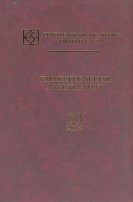ree- ja kelgu-kujundist eesti fraseoloogias
Figure of Sledge in Estonian phraseology
Author(s): Asta ÕimSubject(s): Language and Literature Studies
Published by: Eesti Teaduste Akadeemia Kirjastus
Keywords: lexicon; phraseology; idiomatized expressions
Summary/Abstract: The article focuses on the figurative use of regi and kelk ‘sledge’. The analysed material largely comes from the database of sayings and phraseological expressions at the Estonian Literary Museum. But for a few expressions, the figure of regi / kelk has not stood the test of time and has disappeared from contemporary Estonian. Therefore one cannot find any occurrences of the figurative use of regi / kelk in the Explanatory Dictionary of Estonian; nor can one find such data in bilingual dictionaries of Estonian and some other language. Such usage, however, is covered by older sources, including the dictionaries by Wiedemann and Saareste. It is somewhat unclear why the figurative use of regi / kelk turned out to be unviable in the standard language. The older language reveals a large number of phraseological expressions with regi / kelk. The traditional figure regi /kelk interrelates the means of carriage with mental and social concepts. While metaphorical transfers predominate, in many cases one can understand the idiomatized expressions by means of metonymic projections: regi / kelk > a weight or load on it (i.e. part instead of the whole). The target domain of the metaphor, which is ususally the life of a person, hardships, or human relations, is opposed to a specific means of carriage itself or its load, a heavy item as the source of the metaphor. It means that the source domain highlights a single or a limited number of features of the target domain because each source domain is to play a specific role in the characterization of the target domains where it is applied.
Journal: Emakeele Seltsi aastaraamat
- Issue Year: 2004
- Issue No: 50
- Page Range: 143-158
- Page Count: 15
- Language: Estonian

